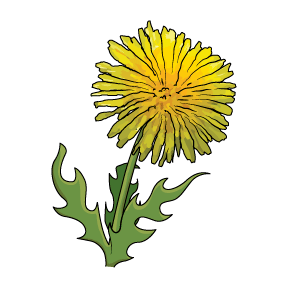By M. M. DONALDSON
Staff writer
Whether your weed is wild or cultivated, it is overlooked by many for its health value or considered a suburban nuisance. Highly recognizable by its serrated dark green leaves and bright yellow flowers, the dandelion packs a punch of vitamins, minerals, protein and fiber.
Wild food instructor Mark Angelini of Eat Here Now based in Southeast Michigan is a professed dandelion muncher. His website offers foraging classes, educational blog posts and recipes for all kind of weeds, but prefers to call them “wild food.”
Dandelion seems to be an old-timer favorite to eat, but it is now becoming readily available in grocery stores and menu options.
Angelini, true to his passion to educate, stated that most dandelion greens sold in supermarkets or in restaurant dishes are most likely not true dandelion, as many organic farms are growing chicory and marketing as dandelion greens. Not necessarily a bait and switch as dandelion belongs to the chicory family. The back-yard gardener will notice the availability of chicory versus dandelion in seed catalogues.
The dandelion has other talents beyond culinary.
Children find the dandelion useful as a chin-tickler to measure someone’s love for butter or to fashion the hollow stalks into bracelets and necklaces.
The dandelion has its roots in Eurasia, but everyone knows it will readily make a home in the most unhospitable conditions, such as a crack in a hot sidewalk. It may be considered a nuisance, but its role in the ecosystem is important as it renews compacted and depleted soils.
Until his death in 1947, Henry Ford worked with the likes of George Washington Carver, Thomas Edison and Harvey Firestone to explore using the milky sap of dandelion for rubber products due to the shortages created by the two world wars. In the last few years, Ford Motor Company has renewed its interest in the ubiquitous weed and has partnered with Ohio State University’s Ohio Agricultural Research on what this sunny yellow flower that evolves into wispy white globes of fluff can do for the auto industry.
Visitors of Greenfield Village, part of the Henry Ford Museum conglomerate can enjoy the dandelion post R&D.
An online recipe for dandelion stew is attributed to Greenfield Village. Although it will not be on this season’s menu at a Taste of History restaurant, executive chef Mike Trombley released that dandelion greens will be part of a featured salad.
A 2003 study published in Plant Foods for Human Nutrition analyzed the nutritional quality of dandelion. Researchers cite the high amount of vitamin C and that it can be consumed in a normal diet, but cautions on its laxative properties.
Angelini stated dandelion greens have the potential to be a popular trend.
“We are already seeing an increase in high-end restaurants and juice bars,” said Angelini, who is also the co-founder of Roots to Fruits, touting edible and ecological landscapes.
More people are recognizing bitter as important to the culinary experience, according to Angelini, noting that kale, another bitter green, has had a massive resurgence.
Some will espouse on the medicinal qualities of dandelion based on the suggestions of scientifically studied results or worse yet, unfounded tabloid claims. The best bet is to eat a variety of veggies, maximizing the intake of nutrients and minimizing the detrimental effect of toxic build up.
As the social norms are broken down to accept eating lawn weeds, those eager to try it may find the costs for a fine dining experience will likely be in the double digits or in an undisturbed patch, free.
M. M. Donaldson is a staff writer with The Voice and a journalism student at WCC. She has a bachelor of science in family and community services from Michigan State University and has several years’ experience with nutrition issues affecting infants through older adults. Follow M. M. Donaldson on Facebook.


